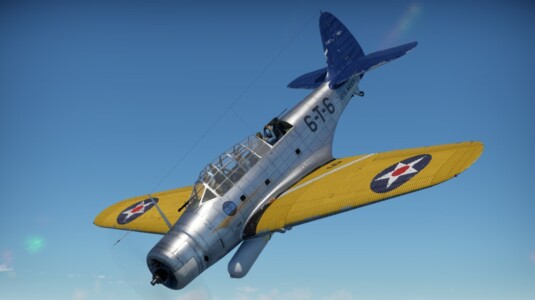Fast Facts – Douglas TBD-1 Devastator
Miles Whittam-Seth wrote this article.
The Devastator came about as a result of the US Navy’s desire to equip its growing carrier fleet with new aircraft designs.
- The aircraft was an advanced design for its day, being the first all metal aircraft to see service with the USN. It had a fully enclosed “greenhouse” canopy for the crew, a retractable undercarriage and hydraulically folding wings.
- The prototype first flew in April 1935 and the type entered squadron service in 1937.
- The Devastator was powered by a single radial engine developing 850 hp and had a maximum speed of 200 miles/hour. Its weapon’s load consisted of 1 x 2,000 pound aerial torpedo or up to 1,500 pounds of bombs, in various combinations.
- It was also armed with 1 x fixed forward firing .50 caliber machine gun, operated by the pilot, and 1 x .30 caliber machine gun, on a flexible mount, for use by the radioman / gunner, seated in the rear crew position.
- Devastators were still in service with all frontline carrier air groups at the outbreak of war with Japan in December 1941 and performed adequately during the early US Navy carrier raids against Japanese held territory in February and March 1942.
- At the battle of the Coral Sea in May 1942, Devastators assisted in sinking the Japanese light carrier Shoho.
- However, the aircraft’s finest and most tragic hour, came one month later at Midway, when three squadrons of Devastators launched unescorted attacks against the Japanese Carrier Force sent to assist in the islands capture.
- The Devastators were armed with torpedoes, which required pilots to make a long straight attack run, flying at no more than 115 mph. This made them easy targets for both the Zero combat air patrol, and the anti-aircraft gunners on the Japanese carriers, and resulted in grievous losses.
- Of the 41 Devastators that carried out the attack, only four returned to their respective US carriers – a loss rate of 90%. VT 8 from the Hornet was almost wiped out to a man, with the only survivor, Ensign George Gay, having a grandstand view of the battle after his aircraft was shot down during its attack run.
- However, our sacrifice wasn’t in vain. It was at this point, with the Japanese anti-aircraft guns firing at maximum depression and the Zeros drawn down to sea level by our attacks, that two squadrons of Dauntless dive bombers, armed with 1,000pound armor piercing bombs, arrived over the Japanese carriers.
- The Dauntless pilots immediately pushed over into their near vertical dives and by the time the Japanese realized the threat, the 1,000 pounders were on their way down and nothing could stop them.
- Three of the four carriers lost by the Japanese at Midway were sunk as a result of this attack.
- After Midway, Devastators were withdrawn from frontline service but continued to serve in second line roles until 1944. Sadly, despite contributing to the destruction of three of the six IJN carriers that attacked Pearl Harbor, not a single Devastator was ear marked for preservation after the end of World War Two.

